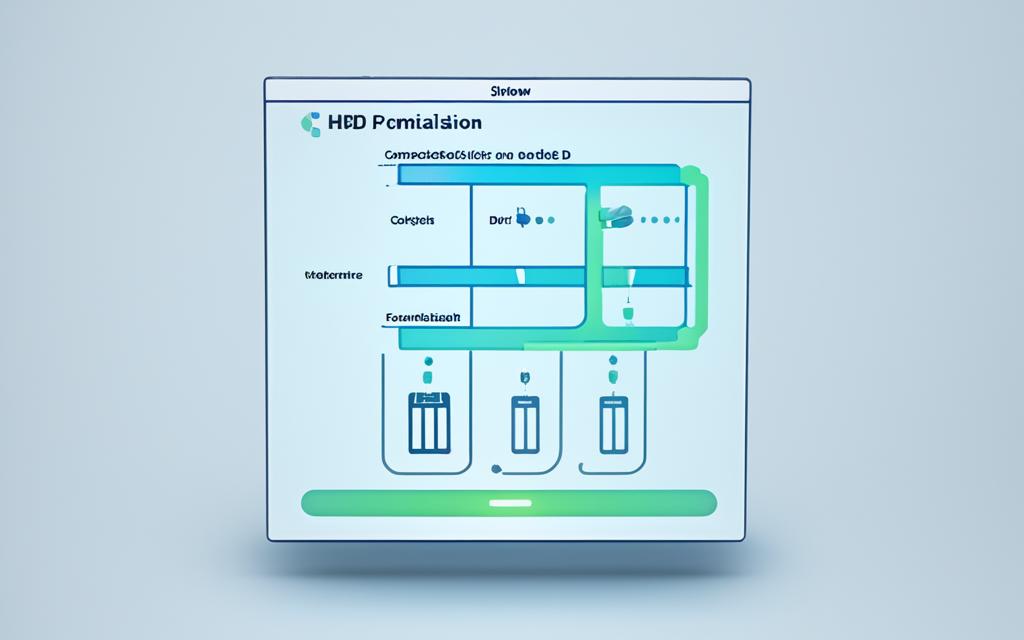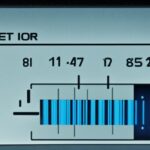Table of Contents
Initializing a hard disk drive (HDD) is a key step in setting up your HDD, making it ready for your computer. It’s crucial when you add a new drive. This ensures it’s properly formatted and ready to store data. This process creates a system that the operating system recognizes. This makes your new storage work smoothly with your computer.
Whether for personal or custom systems, knowing how to initialize an HDD is important. In this guide, we’ll cover everything about HDD initialization. We’ll discuss its importance and how to do it effectively.
By following these steps, you’ll improve your computer’s storage. Plus, it will make your computer use even better. For those interested in more technical details, building your own PC can be a great way to learn and customize.
Key Takeaways
- HDD initialisation is essential for making a new drive detectable and usable.
- It involves choosing between MBR and GPT partition styles.
- Keeping a backup of important data is crucial before initialization.
- Using tools like EaseUS Partition Master Free simplifies the initialization process.
- Common errors during initialization may stem from connection issues or incorrect functions.
- Understanding the differences between 32-bit and 64-bit systems helps in choosing the right partition style.
Understanding HDD Initialization
HDD initialization is a must-do for new hard drives. It makes sure the disk works well with your computer. The process involves formatting the disk and creating a file system for storing and finding data easily.
What is HDD Initialization?
HDD initialization prepares a hard disk for use. It includes creating partitions and formatting. It’s key for any new or reused drive. Not doing it right can cause big problems, like lost data or poor performance1.Learn more about HDD setup here.
Why is it Necessary to Initialize an HDD?
Initializing a HDD is the first step to make a computer and a new hard drive work together. If skipped, the drive might not show up, leading to errors or crashes. Initialized drives use their full potential without any space limits. Always backup data first to avoid losing anything important2.
Common Scenarios for HDD Initialization
There are many reasons to initialize a HDD. Whether it’s a brand-new drive or replacing a failed one, initialization is essential. If you’ve got a large disk or incompatible partitions, reinitializing is necessary1. Facing a “Not initialized” error? Windows’ Disk Management or third-party tools like WorkinTool can help3.
Preparing to Initialize Your HDD
Before you start initializing your HDD, it’s important to get ready properly. You must back up your HDD data first. This is key because initializing will erase everything on the disk. You could lose a lot of important stuff. Use external drives or cloud solutions to keep your data safe during this time.
Back-Up Important Data
It’s crucial to back up your important files to avoid data loss. Make sure to save your documents, photos, and other data to a safe place before starting HDD initialization. This way, you can feel secure knowing your information is safe and can be retrieved easily.
Identifying the Right Disk to Initialize
Picking the right disk for initialization is an essential step. Sometimes, Windows users find that a new disk doesn’t show up in File Explorer. This means it needs to be initialized. Many users today prefer the GPT format. It works for drives over 2 TB. Always check your disk type before starting. Changing from MBR to GPT deletes everything, which can’t be reversed4
| Method of Initialisation | Complexity Level | Time Required |
|---|---|---|
| EaseUS Partition Master | Easiest | 0:00-0:18 for MBR, 0:19-0:44 for GPT |
| Disk Management | Medium | 3-5 minutes |
| Command Prompt (CMD) | Difficult | Varies |
Your decision to use MBR or GPT depends on your hard drive’s size and your system’s needs5. Knowing these details helps you prepare better. Then you can start initializing your HDD with confidence45.
How to Initialize an HDD Using Disk Management
When you decide to initialize an HDD, using the built-in Disk Management Windows tool is easy. It makes sure your disk is ready for storing data. You’ll need to choose between two partition styles: MBR or GPT. Learning how to initialise HDD can save time and make disk usage efficient.
Accessing Disk Management
First, you need to open the Disk Management utility to start the HDD initialisation. Simply search for ‘Disk Management’ in the taskbar search box. Remember to run it as an administrator. This tool shows you all connected disks and their statuses. This makes starting the initialization process easier.
Steps to Initialize the Disk
Follow these steps in Disk Management to initialize your HDD:
- In Disk Management’s lower section, find the new disk labeled as ‘Not Initialised’. Right-click it and select ‘Initialize Disk’.
- You will then choose between MBR and GPT partition styles. MBR supports up to 4 primary partitions, while GPT can have up to 12867.
- Selecting MBR for disks over 2 TB may cause issues, as MBR can’t support large drives7.
- After picking a partition style, click ‘OK’ to erase any existing data on the disk. This prepares it for Windows use.
- Next, you can create new partitions and format them. Make sure to pick a format that meets your needs.
If you run into problems during initialization, DiskInternals Partition Recovery can help recover lost data7. Alternatively, AOMEI Partition Assistant Standard makes disk management easy. It lets you switch between MBR and GPT easily6.
For more detailed guidance on HDD initialisation in Windows, check the documentation here6.
Alternative Methods to Initialize HDD
Exploring different ways to start an HDD can be very effective. The PowerShell HDD command is a strong method for those who know a bit about scripting. Using the ‘Initialize-Disk’ cmdlet in PowerShell, users can start an HDD with commands. This offers more control for those who understand coding.
Using PowerShell for Initialization
Using the PowerShell HDD command makes starting the process simpler. It’s especially handy for managing many disks or for automatic tasks. It’s vital to choose between MBR or GPT when you start a disk, depending on your needs. MBR is good for hard disks up to 2TB but GPT works for bigger storage, supporting up to 9.4ZB and 128 primary partitions, unlike MBR’s four8. Always check for bad sectors before you begin to avoid problems during starting9.
Third-Party Tools for HDD Initialization
Third-party HDD tools like MiniTool Partition Wizard and AOMEI Partition Assistant offer useful features for HDD starting. They’re easy to use and can recover lost partitions if something goes wrong10. These tools also help with common error messages during disk starting. They make sure your hard drive is ready to use and reduce the risk of losing data8.
FAQ
What is HDD initialization?
HDD initialization prepares a new hard drive for the operating system. It formats the disk and sets up a file system. This is so you can save and find your files easily.
Why is it necessary to initialize an HDD?
Initializing an HDD makes sure your computer can see the disk. This lets you save and read your files. Without initializing, your hard drive won’t work.
What should I do before initializing my HDD?
Before initializing, back up any crucial data on the disk. Use external drives or cloud storage for your important files. This protects your data.
How can I access Disk Management on Windows?
To find Disk Management on Windows, search for ‘Disk Management’ on the taskbar. Then run it as an admin. It’s a handy tool for handling disks and partitions.
What steps are involved in initializing an HDD using Disk Management?
In Disk Management, right-click the disk to initialize and choose ‘Initialize Disk’. Then follow the steps to set up your disk for use. This gets it ready for storing data.
Can I initialize my HDD using PowerShell?
Yes, you can use PowerShell to initialize an HDD. The ‘Initialize-Disk’ cmdlet is for those who prefer command-line tools. It gives you more control over the initialization.
Are there third-party tools available for HDD initialization?
Absolutely! Several third-party tools offer more features for HDD initialization. They provide more options for formatting and partitioning your drives.
Source Links
- https://www.diskpart.com/articles/reinitialize-hard-disk-0725.html – How to Reinitialize Hard Disk on Windows PC?
- https://4ddig.tenorshare.com/hard-drive/does-initializing-a-disk-erase-data.html – [2024 Updated] Does Initializing a Disk Erase Data?
- https://www.workintool.com/data-recovery-tips/initialize-disk-without-losing-data.html – Initialize Disk Without Losing Data on Windows 10/11
- https://learn.microsoft.com/en-us/windows-server/storage/disk-management/initialize-new-disks – Initialize new disks
- https://www.easeus.com/partition-manager-software/initialize-a-hard-drive.html – Full Guides: Initialize a Hard Drive on Windows 10/11
- https://www.diskpart.com/windows-11/disk-management-windows-11-initialize-disk-3690.html – How to Use Disk Management on Windows 11 to Initialize Disk
- https://www.diskinternals.com/partition-recovery/initialize-disk/ – Why disk may demand initialization and how to not lose data after it
- https://www.diskpart.com/articles/you-must-initialize-a-disk-1984.html – 5 Methods of You Must Initialize a Disk Without losing data
- https://www.resize-c.com/howto/cannot-initialize-disk-external-hdd-that-shows-uninitialized.html – Cannot Initialize Disk External HDD That Shows Uninitialized
- https://www.partitionwizard.com/partitionmagic/disk-unknown-not-initialized.html – Full Solutions to Fix Disk Unknown Not Initialized (2 Cases) – MiniTool Partition Wizard








